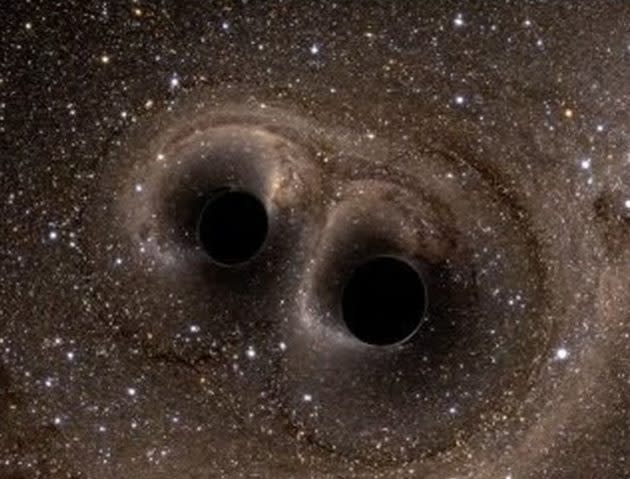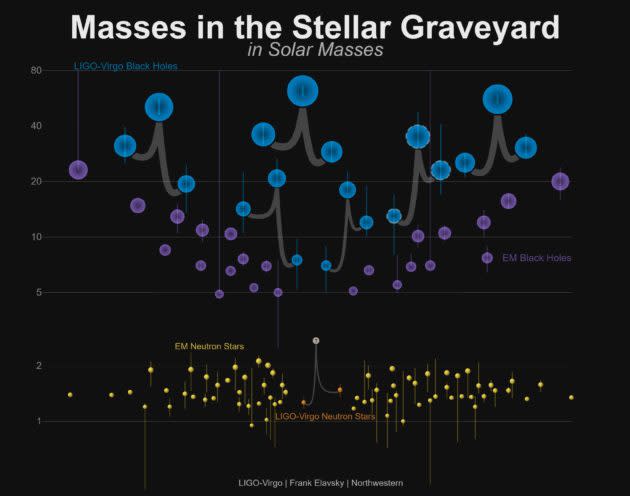LIGO gravitational-wave hunters get lucky and find smallest black hole merger

It took months to figure it out, but the scientists in charge of the Laser Interferometer Gravitational-wave Observatory, or LIGO, have confirmed their observations of the most lightweight black hole merger yet.
The latest detection provides further confirmation of Einstein’s general theory of relativity — and will help physicists hone their routine for combining observations from different types of scientific instruments, an approach known as “multi-messenger astronomy.”
Scientists say the spike in gravitational waves known as GW170608, detected on June 8, was set off by the smashup of two black holes weighing seven and 12 times as much as our sun.
The crash produced a merged black hole that’s 18 times as massive as the sun, with the equivalent of one solar mass converted into the energy of the gravitational waves. Those waves rippled across the fabric of spacetime for roughly a billion years to trigger the LIGO detectors at Hanford, Wash., and Livingston, La.
In this video version, you can see just how much longer #GW170817 lasts compared to our black hole signals, even #GW170608. pic.twitter.com/0zjof9jnYM
— LIGO (@LIGO) November 16, 2017
Confirming the detection was a close thing: LIGO’s Livingston facility had a clear signal, but the equipment at Hanford was undergoing adjustments after a round of routine maintenance.
Both of LIGO’s detectors pick up on the ever-so-slight perturbations in spacetime by measuring minute changes in spatial dimensions, using a system of lasers and mirrors. At the time that the GW170608 signal arrived, Hanford’s scientists were shaking the mirrors to check how much “noise” there was in the system.
To double-check the Livingston observations against the Hanford data, the LIGO team had to exclude the frequencies that were affected by the mirror-shaking exercise. Fortunately, scientists were still able to see the signature of the gravitational waves in the unaffected frequencies.
Weeks later, in August, LIGO’s detectors and the Virgo gravitational-wave observatory in Italy picked up signals from a bigger black hole merger as well as a clash of neutron stars. LIGO said in a news release that the time required to understand those discoveries forced a delay in the analysis and publication of the June 8 findings.
“Pretty much everything was dropped following the detection of our first binary neutron star system,” Christopher Berry, a member of the LIGO team from the University of Birmingham in England, explained in a blog posting. Now the team is “starting to dig our way out” of the data backlog, he said.
Virgo was getting ready for the Aug. 1 start of operations when the June event happened. Although the European observatory wasn’t able to provide meaningful data about the event, Virgo’s scientists were able to contributed to the post-event analysis.
Hundreds of scientists from the LIGO and Virgo collaborations are listed as authors for a research paper on the June 8 event, submitted this week for publication in the Astrophysical Journal Letters.
LIGO now has five confirmed black hole mergers on its detection list, plus the neutron star merger. For the next year or so, the LIGO and Virgo detectors will be offline for upgrades, but scientists are continuing to check the data from their recently concluded observing run for events that may already be in the can.
Once observations resume with the upgraded detectors in late 2018, “detection of black hole binaries will be a routine occurrence,” the researchers write. They say “studying this population will eventually answer many questions about these systems’ origins and evolution.”
More from GeekWire:
This black hole crash expands the frontier for gravitational wave hunters at LIGO
A cosmic first! Gravitational waves and telescopes reveal the clash and flash of neutron stars
LIGO gets lit up again by gravitational waves from another black hole crash
Europe’s Virgo detector picks up its first gravitational wave and nails down locale

